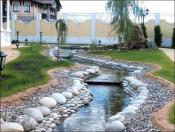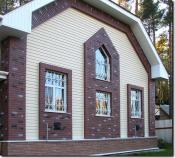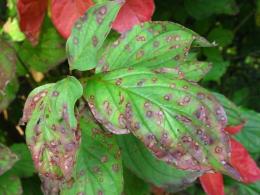Search
Login
Recommended
Raspberries: raspberry disease, raspberry pests. Ways to deal with raspberry diseases and pests
There are many paradoxes associated with the amazing raspberry berry, about which legends are passed down from generation to generation. First of all, the raspberry family is surprising, which, in fact, is not even a shrub, but just a shrub grass. Raspberry, being the number one folk remedy for respiratory viral diseases, rich in vitamins, trace elements and pectins, is itself under the daily supervision of a huge number of pests and is at risk of many viral and fungal infections.
Content
- A variety of raspberry diseases
- Fungal lesions of raspberries. Gray Rot and Anthracnose
- White and purple spotting
- Common Raspberry Pests video
- Pest Prevention
A variety of raspberry diseases
It is believed that new repair varieties aimed at increasing yields and deliberately protected by breeders from any misfortunes are completely resistant to various kinds of damage, since it combines properties that provide increased resistance to pests and diseases. But, unfortunately, this is fundamentally wrong, especially if varieties of remont raspberries grow in the neighborhood with varieties of ordinary raspberries.

Diseases of raspberries, their photos you can see below, it is customary to share in accordance with their pathogen. Thus, fungal and viral lesions can be distinguished, which will be appropriate to consider in this article.

In accordance with the classification, the main fungal diseases of raspberries are gray rot, anthracnose, various spots, often white, purple and ulcerative, a detailed discussion of which is presented below.

Fungal lesions of raspberries. Gray Rot and Anthracnose
Among the fungal pathogens of raspberries, the palm tree rightfully belongs to gray rot, the first signs of which are manifested in the form of medium-sized gray spots localized on drupes, and then occupying most of the berry with its subsequent active decay.

The berries are distinguished by the presence of gray rot, which, in fact, is a massive accumulation of fungal pathogens. Gray rot epidemics are predominantly common in rainy seasons and can lead to crop losses in excess of 50%. To prevent damage by gray rot, it is recommended to dust the soil around plants with wood ash or crushed coal.

The causative agent of anthracnose spreads mainly on leaves, petioles, shoots and berries. It is prone to lesions of leaves and stems of annual shoots, with subsequent involvement in the defeat of the young growth of two-year-old shoots. Symptoms of the defeat are the appearance of small rounded spots of gray color with a purple border located along the edges of the leaves and along the veins.

With mass lesions, the spots are prone to central fusion, and the leaves curl and fall off. On the petioles, the disease is manifested by the appearance of small impressions resembling ulcers with their subsequent merger. Parts of affected biennial shoots also do not survive. Prevention of anthracnose consists in the spring treatment of the berry with a 1% Bordeaux mixture, which must be carried out at the very beginning of budding.

White and purple spotting
The causative agent of white spotting in most cases is a threat to wild berries, from which I can easily infect the plantings of garden raspberries. The fungus that causes white spotting is localized on the leaves and stem shoots, and the beginning of the lesion is manifested by the formation of rounded brown spots, followed by bleaching of spots with black pathogen pycnids in the center. Pycnids are massive clusters of pathogen spores. The consequences of widespread white spotting infection are the destruction of infected leaf tissue, followed by the merging of spots together and covering them with whole leaves. With stem damage, the pathogen is localized in the immediate vicinity of the kidneys. Measures to combat white spotting fungus include spraying shrubs with a solution of colloidal sulfur, consisting of 50 grams of dry matter and 10 liters of water. Processing should be done after the final harvest.

As part of the discussion of the topic of diseases and pests of raspberries and their control, the photo is also presented in the article, the mention of purple spotting, which is also a common raspberry disease, will be relevant. Purple spotting is characterized by the primary spread of the disease on young shoots, which is manifested by the formation of brown-purple spots that do not have clear boundaries. In the future, they grow and surround the shoot along its entire length. Signs of leaf damage include the formation of necrotic spots, which cause them to dry out. The basic principles for controlling purple spotting are to remove the affected shoots just below the soil level. Prevention is aimed at ensuring free air access, which ensures optimal thinning of the plantings, and eliminating excessive watering.

Raspberry viral diseases often occupy only the bushes and root system of the plant. The main viral lesions of raspberries are recognized as mosaic, curliness and viral chlorosis, the main preventive measures of which are aimed at destroying aphids by spraying the plant with an insecticide. The cause of viral chlorosis can also be an increase in the acidity of the soil, and in this case, the fight against the disease is aimed at reducing the acidity of the soil mixture.

Common Raspberry Pests
Not only diseases, but also a pest are capable of reducing raspberry productivity, of which there are also a great many. The main representatives of the harmful fauna are: raspberry-strawberry weevil, raspberry beetle, spider and raspberry mites, raspberry bud moth, as well as raspberry stem fly and gall midge.
Perhaps one of the most common pests of raspberries can be called raspberry stem gall midge, which affects the stems of the plant.

Raspberry stem gall midge is a small mosquito of black color that encompasses raspberries en masse during the flowering period and lays eggs on new shoots, as a result of which a month later galls of orange larvae appear, pupating upon reaching a length of 4 mm. The fight against raspberry gall midge is aimed at mass cutting and destruction of affected raspberry stalks. Another common way of influencing the gall midge is to spray the bottom of the shoots with a 30% malathion emulsion.

Pest Prevention
Summing up the article, in which raspberry diseases and the fight against them were examined, it is necessary to emphasize once again that any activity should be, first of all, preventive. With absolutely exact observance of agrotechnical measures at the stage of raspberry cultivation, there will be no need for additional processing of plantings with products of the chemical industry.

The principles of basic agricultural measures designed for preventive actions to combat diseases and pests are based on the following points:
Firstly, in the autumn or early spring period it is necessary to collect plant residues, which are subsequently subjected to composting or burning. This will help to eliminate the existing infection;

Secondly, cutting stems, burning their lower part, removing vegetation residues and high-quality loosening of the soil sharply reduce the spread of both pests and diseases;
And, finally, the spread of pests and diseases is prevented by planting some cultivated plants in the ranks of raspberries. A vivid example of this is the calendula, which protects raspberry plantations from the spread of ticks and rot, and dill, which is also able to deter harmful insects.






